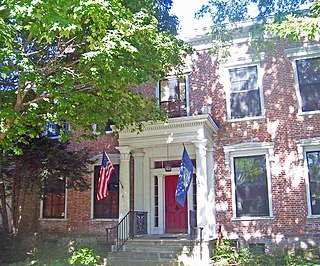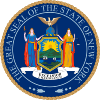Defamation is the act of communicating to a third party false statements about a person, place or thing that results in damage to its reputation. It can be spoken (slander) or written (libel). It constitutes a tort or a crime. The legal definition of defamation and related acts as well as the ways they are dealt with can vary greatly between countries and jurisdictions.
Hustler Magazine, Inc. v. Falwell, 485 U.S. 46 (1988), was a landmark decision of the United States Supreme Court ruling that the First and Fourteenth Amendments prohibit public figures from recovering damages for the tort of intentional infliction of emotional distress (IIED), if the emotional distress was caused by a caricature, parody, or satire of the public figure that a reasonable person would not have interpreted as factual.

Hill v Church of Scientology of Toronto February 20, 1995- July 20, 1995. 2 S.C.R. 1130 was a libel case against the Church of Scientology, in which the Supreme Court of Canada interpreted Ontario's libel law in relation to the Canadian Charter of Rights and Freedoms.

John Peter Zenger (October 26, 1697 – July 28, 1746) was a German printer and journalist in New York City. Zenger printed The New York Weekly Journal. He was accused of libel in 1734 by William Cosby, the royal governor of New York, but the jury acquitted Zenger, who became a symbol for freedom of the press.
New York Times Co. v. Sullivan, 376 U.S. 254 (1964), was a landmark U.S. Supreme Court decision ruling that the First Amendment to the U.S. Constitution's freedom of speech protections limit the ability of American public officials to sue for defamation. The decision held that if a plaintiff in a defamation lawsuit is a public official or candidate for public office, not only must they prove the normal elements of defamation—publication of a false defamatory statement to a third party—they must also prove that the statement was made with "actual malice", meaning the defendant either knew the statement was false or recklessly disregarded whether it might be false.
Gertz v. Robert Welch, Inc., 418 U.S. 323 (1974), was a landmark decision of the US Supreme Court establishing the standard of First Amendment protection against defamation claims brought by private individuals. The Court held that, so long as they do not impose liability without fault, states are free to establish their own standards of liability for defamatory statements made about private individuals. However, the Court also ruled that if the state standard is lower than actual malice, the standard applying to public figures, then only actual damages may be awarded.
Sedition and seditious libel were criminal offences under English common law, and are still criminal offences in Canada. Sedition is overt conduct, such as speech and organization, that is deemed by the legal authority to tend toward insurrection against the established order: if the statement is in writing or some other permanent form it is seditious libel. Libel denotes a printed form of communication such as writing or drawing.
Fair comment is a legal term for a common law defense in defamation cases. It is referred to as honest comment in some countries.
Milkovich v. Lorain Journal Co., 497 U.S. 1 (1990), was a United States Supreme Court case that rejected the argument that a separate opinion privilege existed against libel. It was seen by legal commentators as the end of an era that began with New York Times Co. v. Sullivan and continued with Gertz v. Robert Welch, Inc., in which the court clarified and greatly expanded the range and scope of what could be said in the press without fear of litigation.
James Thomson Callender was a political pamphleteer and journalist whose writing was controversial in his native Scotland and later, also in the United States. His revelations concerning George Washington, Alexander Hamilton, and later Thomas Jefferson, led to his marginalization politically. His contemporary reputation as a "scandalmonger" has overshadowed Callender's frequently perceptive analyses of revolutionary events. He wrote against the continuing influence of the British Crown, and he warned that Adams, Washington and Hamilton planned to impose a titled aristocracy and hereditary positions in the Senate and the Executive. In the United States, he was a central figure in the press wars between the Federalist and Democratic-Republican parties. After Jefferson won the presidency, Callender solicited employment as a postmaster, which was denied by Jefferson. Callender then published existing rumors claiming President Jefferson had children with slave Sally Hemings.
Neutral reportage is a common law defense against libel and defamation lawsuits usually involving the media republishing unproven accusations about public figures. It is a limited exception to the common law rule that one who repeats a defamatory statement is just as guilty as the first person who published it.
Modern libel and slander laws in many countries are originally descended from English defamation law. The history of defamation law in England is somewhat obscure; civil actions for damages seem to have been relatively frequent as far back as the Statute of Gloucester in the reign of Edward I (1272–1307). The law of libel emerged during the reign of James I (1603–1625) under Attorney General Edward Coke who started a series of libel prosecutions. Scholars frequently attribute strict English defamation law to James I's outlawing of duelling. From that time, both the criminal and civil remedies have been found in full operation.
The origins of the United States' defamation laws pre-date the American Revolution; one influential case in 1734 involved John Peter Zenger and established precedent that "The Truth" is an absolute defense against charges of libel. Though the First Amendment of the U.S. Constitution was designed to protect freedom of the press, for most of the history of the United States, the U.S. Supreme Court failed to use it to rule on libel cases. This left libel laws, based upon the traditional "Common Law" of defamation inherited from the English legal system, mixed across the states. The 1964 case New York Times Co. v. Sullivan, however, radically changed the nature of libel law in the United States by establishing that public officials could win a suit for libel only when they could prove the media outlet in question knew either that the information was wholly and patently false or that it was published "with reckless disregard of whether it was false or not". Later Supreme Court cases barred strict liability for libel and forbade libel claims for statements that are so ridiculous as to be obviously facetious. Recent cases have added precedent on defamation law and the Internet.

Canadian defamation law refers to defamation law as it stands in both common law and civil law jurisdictions in Canada. As with most Commonwealth jurisdictions, Canada follows English law on defamation issues.

The First Columbia County Courthouse is located along NY 23B near the center of the hamlet of Claverack, New York, United States. It is a brick building in the Federal style constructed in 1786 and renovated in the mid-19th century.

Grant v Torstar Corp, [2009] 3 S.C.R. 640, 2009 SCC 61, is a 2009 Supreme Court of Canada decision on the defences to the tort of defamation. The Supreme Court ruled that the law of defamation should give way to the rights of a party to speak on matters of public interest, provided the party exercises a certain level of responsibility in verifying the potentially defamatory facts. This decision recognizes a defence of responsible communication on matters of public interest.
Harte-Hanks Communications Inc. v. Connaughton, 491 U.S. 657 (1989), was a case in which the Supreme Court of the United States supplied an additional journalistic behavior that constitutes actual malice as first discussed in New York Times Co. v. Sullivan (1964). In the case, the Court held that departure from responsible reporting and unreasonable reporting conduct alone were not sufficient to award a public figure damages in a libel case. However, the Court also ruled that if reporters wrote with reckless disregard for the truth, which included ignoring obvious sources for their report, plaintiffs could be awarded compensatory damages on the grounds of actual malice.

The Defamation Act 2013 is an Act of the Parliament of the United Kingdom, which reformed English defamation law on issues of the right to freedom of expression and the protection of reputation. It also comprised a response to perceptions that the law as it stood was giving rise to libel tourism and other inappropriate claims.

Harry Croswell was a crusading political journalist, a publisher, author, and an Episcopal Church clergyman. Though largely self-educated, he received an honorary degree of A. M. from Yale College in 1817, an honorary Doctorate of Divinity from Trinity College, Hartford, Connecticut in 1831 – an institution he co-founded – established the first public lectures in New Haven, and founded an evening school for the education of adult African-Americans in the city. He was a key figure in first amendment battles over freedom of the press and religious freedom. After abandoning politics for religion, he became the much respected Rector of Trinity Church on the Green in New Haven, Connecticut, for forty-three years, growing his church and establishing seven new churches within the original limits of his parish. Though he published fourteen books, and wrote newspaper articles as an editor and journalist weekly for eleven years, he is best known as an author for being the first person to define the word cocktail in print.

The New York Weekly Journal was a weekly journal, printed by John Peter Zenger, from November 5, 1733 to March 18, 1751. It was the second journal in New York City and the only one that criticized New York Royal governor William Cosby, for which reason the journal was burned in its first year and John Zenger was put in prison. Zenger was released without charges, this being one of the earliest cases where a fight for the freedom of press led to a victory in America.








